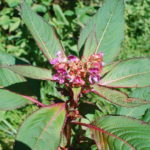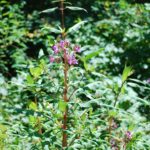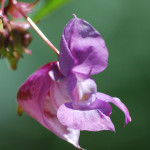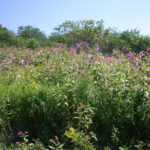Gallery:
- Policeman’s helmet
- A mature flowering policeman’s helmet plant
- Policeman’s helmet flower
- The showy flowers of policeman’s helmet
- Policeman’s helmet seeds and exploded pod
- A dense infestation of mature policeman’s helmet plants
Common names:
Policeman’s helmet, ornamental jewelhead, Himalayan balsam
Scientific Name:
Impatiens glandulifera
Description:
Policeman’s helmet is a showy, succulent annual in the Balsaminaceae (balsam) family. It was introduced as an ornamental plant, but it easily escapes cultivation and becomes invasive. The stems are hollow and succulent, with long leaves coming out at the nodes. The leaves have serrated margins and flowers that resemble old-fashioned English policeman’s helmets (thus, the name). A single plant can produce up to 800 seeds that are ejected up to 20 feet when ripe.
Life cycle:
Height of mature plants
Up to 8 feet
Flower color:
White to pink to purple
Bloom time:
June – August
Look-a-likes:
Policemen’s helmet looks very similar to other Impatiens species. However, the combination of the flower color (white, pink or purple vs the yellow-orange of other species), strongly serrated leaf edges, and the height make it fairly easy to distinguish.
Habitat:
Policeman’s helmet grows very well in moist natural areas, so it is often found along shady streams, ditches, and in moist forests.
Impacts:
Policeman’s helmet spreads rapidly, producing up to 800 seeds that can live a year and a half. They can form dense patches that exclude other native plants. Because they are annuals, they die in the summer, leaving behind bare soil which causes erosion and water quality problems.
Noxious Weed Listing:
- WeedWise: Priority
- State of Oregon: Class B
- State of Washington: Class B
- Four County CWMA: Class B
- Columbia Gorge CWMA: Class B
Origin:
Asia (western Himalayas and India)
Links:
Oregon Noxious Weed Profile
Washington Noxious Weed Profile
Invasive.org Profile
CABI Invasive Species Compendium
Impatiens Identification Brochure






